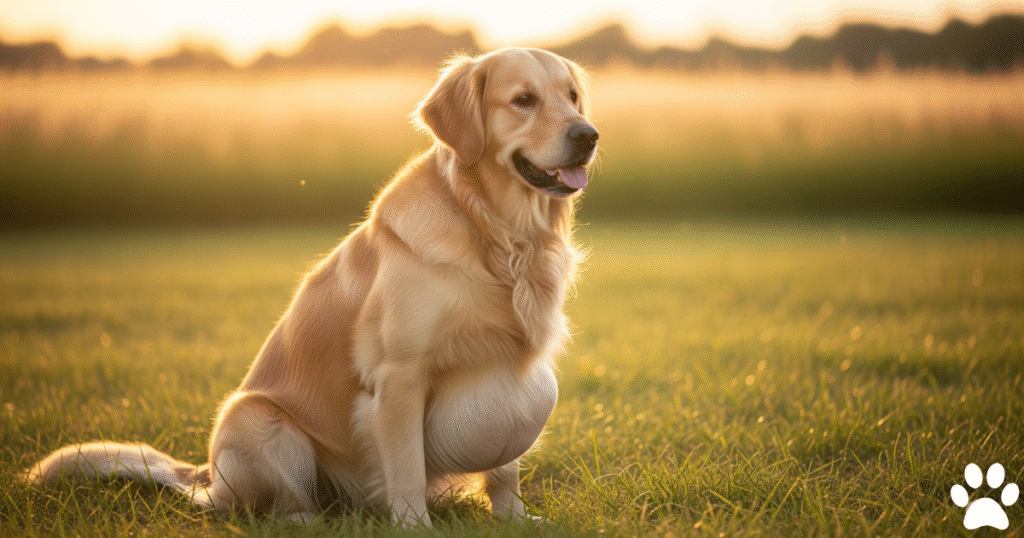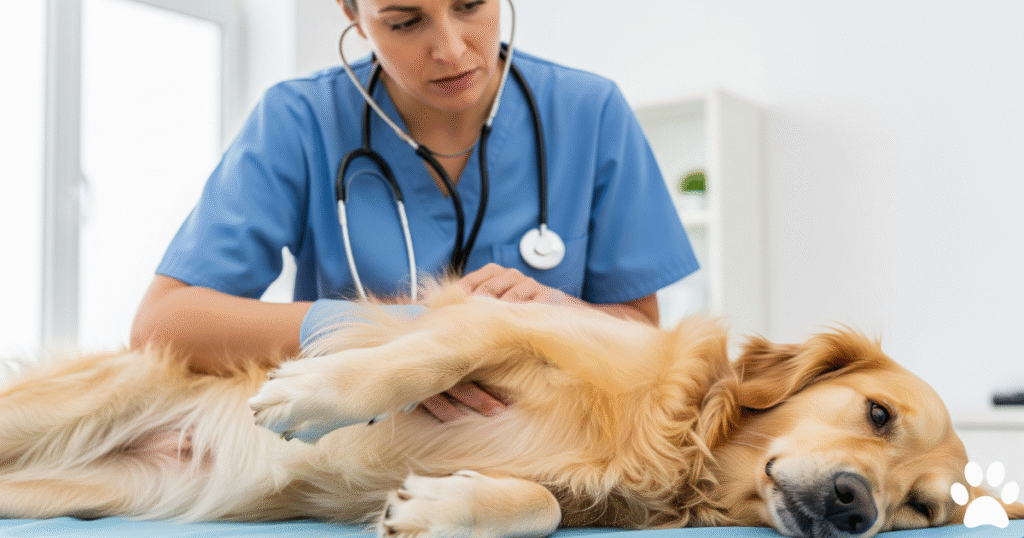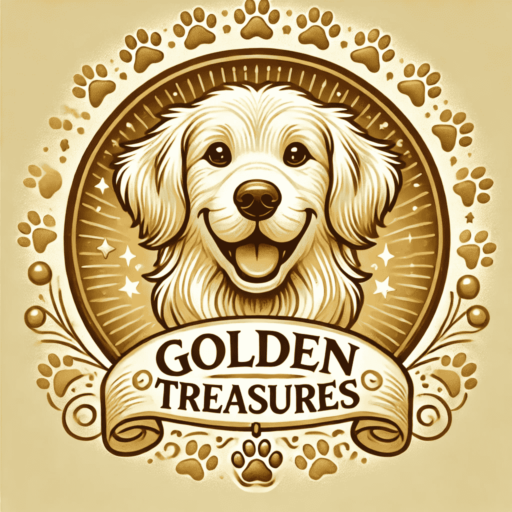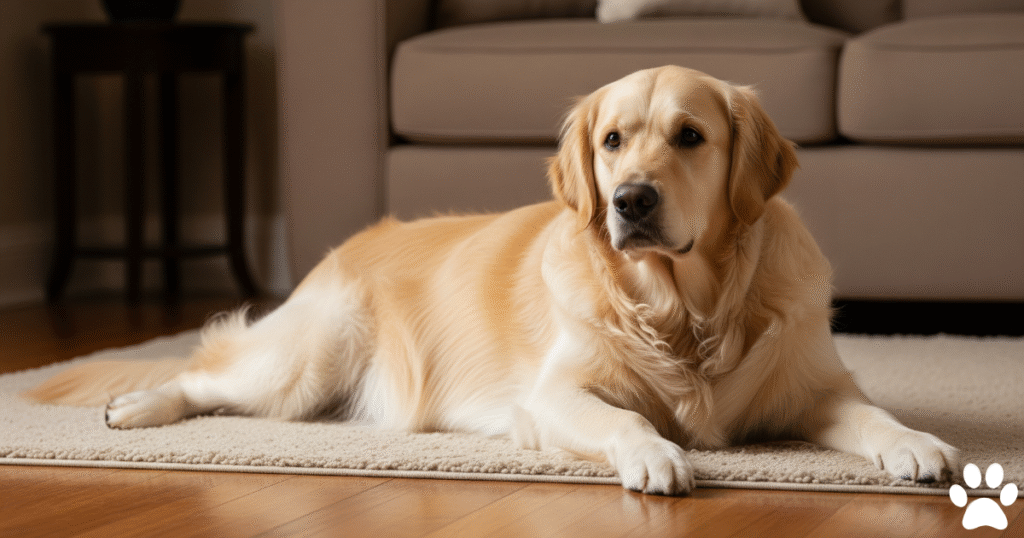If you’re the proud owner of a Golden Retriever, recognizing signs of bloat in dogs means the difference between life and death. Also known as gastric dilation, bloat is a rapidly developing condition in which your dog’s stomach fills with air and can cause them to go into spasms—a life-threatening emergency that often requires immediate surgery. While all breeds can be affected, Golden Retrievers are particularly vulnerable due to their large size, deep chest, and high activity level after eating. Bloat in dogs is often mistaken for a minor stomach problem, but it can actually get worse within minutes. That is why understanding the early warning symptoms is critical. From visible bloating and gagging to unusual behavior like pacing or restlessness, each sign is a warning sign. And while some dogs will experience dramatic changes, others may only have subtle signs, especially at first.
In this blog, we’ll discuss 13 warning signs of bloat in dogs, focusing on how it manifests itself in golden retrievers. You’ll also learn how to tell the difference between simple bloat and life-threatening diarrhea, what symptoms indicate an emergency, and what to look for in puppies. As you read, remember that bloat can get worse quickly. Bloat in dogs can get worse in as little as an hour, so being well-informed can literally save your dog’s Health and Life.
Contents
- 1 Why Recognizing Signs of Bloat Early Can Save Your Golden Retriever’s Life
- 2 What are the first signs of bloat in dog?
- 3 Symptoms of Bloat in Dogs That Indicate Emergency
- 4 Puppy Bloat Signs: What to Look for in Young Golden Retrievers
- 5 How to Tell If Your Dog Has Bloat vs. Other Conditions
- 6 When to Go to the Vet: Don’t Wait for It to Get Worse
- 7 Quick Checklist: Signs of Bloat in Dogs at a Glance
- 8 Final Thoughts: Trust Your Gut—Bloat Isn’t Just a Tummy Ache
Why Recognizing Signs of Bloat Early Can Save Your Golden Retriever’s Life
Bloat in dogs is not only unpleasant but can also be fatal if not treated promptly. Early detection of the signs of bloat in dogs can greatly improve the chances of survival and Health of your dog, especially in breeds like the Golden Retriever that are genetically predisposed to it. Golden Retrievers are deep-chested, active, and love to eat — traits that unfortunately put them at higher risk for GDV. This condition can quickly progress to gastric diversion volvulus (GDV), in which the dog’s stomach twists and traps gas and fluid. This stops blood flow to crucial organs like the heart. Without emergency surgery, dogs can go into shock and die within hours.
Understanding the Urgency of Gastric Diversion Volvulus in Dogs
Bloat in dogs takes a surprisingly short time to develop. In many cases, pet owners have less than an hour or two to get their dog to the vet after the first symptoms appear. That’s why it’s important to recognize the early signs of bloat in dogs, such as restlessness, gagging, or bloating. Delaying treatment — sometimes for up to 30 minutes — can lead to permanent organ damage or death. Even with mild symptoms, prompt action is always the safest option. Don’t overreact to gastric diversion — it could save your Golden Retriever’s life.
Why Golden Retrievers Are at Higher Risk
Several factors make bloating more common in Golden Retrievers than in smaller breeds or those with different body types:
- Body type: A deep, narrow chest makes gastric diversion easier.
- Eating habits: Many Golden Retrievers gulp down food or water quickly, forcing themselves to swallow more air, which results in water bloating.
- Genetics: Research shows that large breeds, especially purebred dogs, are more likely to develop gastric diversion.
- Age and stress: Older and stressed dogs are also at higher risk.
What are the first signs of bloat in dog?
When it comes to bloat in dogs, early detection is crucial. However, many pet owners ask, “What are the first signs of bloat in dog?” In fact, they are often subtle, especially in the early stages, but signal a dangerous condition quickly developing beneath the surface. With Golden Retrievers, it is important to be vigilant, even after a normal meal or play session. A dog that appears healthy one moment may show signs of discomfort the next.
Physical Signs – Bloating, Dry Vomiting, Drooling
The first signs of bloat in dogs usually begin with visible discomfort:
Swollen or Tight Belly:
One of the most obvious visible signs. The belly may feel hard and noticeably distended.

Dry or Ineffective Vomiting:
Your dog may try to vomit, but nothing comes out. This is a clear warning sign.
Excessive drooling:
Saliva may pool around the mouth or drip excessively.
These physical signs of GDV in dogs can appear quickly and be mistaken for bloating or overeating. Don’t make this mistake – take all symptoms seriously.
Behavior Changes – Restlessness, Pacing, Attention to Stomach
Behavior changes are just as important as the physical signs. Early behavioral signs include:
Restlessness or pacing:
Your Golden Retriever may appear uncomfortable, unable to lie down, or pacing in circles.
Whining or signs of restlessness:
If your normally calm dog suddenly becomes panicked or agitated, pay close attention.
Pacing or biting the abdomen:
Many dogs repeatedly palpate their abdomen or attempt to lick or bite it, indicating pain or pressure.
Symptoms of Bloat in Dogs That Indicate Emergency
As bloating progresses, symptoms of bloat in dogs become more severe and dangerous. What starts out as restlessness or wheezing can quickly escalate to a full-blown collapse. If you notice these symptoms in your Golden Retriever, it’s no longer a minor problem — it’s a veterinary emergency. Golden Retrievers are especially vulnerable due to their anatomy and genetics. In severe cases of bloat, quick solutions can save your dog’s life. Never wait for the situation to improve on its own.
Progressive Symptoms — Collapse, Pale Gums, Rapid Breathing
As your Golden Retriever reaches the later stages of gastric diversion, the following symptoms may occur:
Collapse or inability to stand:
Your dog may appear weak, dizzy, or suddenly fall over.
Pale or bluish gums:
Lift the lower lip – if the gums are not pink, your dog may be in shock.
Rapid or shallow breathing:
The bloated belly presses on the diaphragm, making it difficult for your dog to breathe.
Cold extremities:
The ears, paws, or tail may be cold due to decreased blood flow.
When the Bloat Turns to GDV
In some cases, bloat progresses to a more serious condition called gastric dilatation-volvulus (GDV). This is when the stomach not only fills with air, but also twists, cutting off blood flow to the organs. In this case, surgery is often the only life-saving treatment. If your golden retriever is showing signs of collapse, has pale mucous membranes, or is breathing rapidly, he may already be suffering from GDV. Learn more about this condition and how to act quickly in our comprehensive guide to GDV in dogs.
Puppy Bloat Signs: What to Look for in Young Golden Retrievers
Golden retriever puppies are full of energy, but they also have a sensitive digestive system. When raising puppies, it’s important to recognize the early puppy bloat signs, as it doesn’t just happen in adult dogs. Young dogs can be even more susceptible due to their habit of eating quickly, high levels of stress after eating, and their still-developing digestive systems. While the symptoms of bloat in dogs in dogs are generally the same from age to age, they can appear different or more subtle in puppies. Therefore, owners of golden retriever puppies should be vigilant, especially after eating or intense play.

Is It Just Gas or Something Serious?
Puppies are known for having occasional gas and mild discomfort. But how do you know if there’s something else going on? These puppy bloat signs are often mistaken for overeating or a mild upset stomach. However, if the symptoms come on suddenly and don’t go away within 30 minutes, you should take them seriously. Look for the following warning signs:
- A tense, bloated abdomen, even if you haven’t eaten much
- Screaming or fidgeting, as if you’re lying down uncomfortably
- Dry whining or gagging without vomiting
- Sudden changes in energy – where your playful pup becomes lethargic or restless
Special Considerations for Golden Retriever Puppies
Golden Retriever puppies tend to be fast eaters, play aggressively, and get excited easily – all risk factors for gastric torsion. Since puppies can’t clearly communicate their pain, it’s even more important to pay attention to the subtle symptoms of bloat in dogs. If something doesn’t seem clear to you, trust your instincts and contact your veterinarian. Taking early action can save your puppy’s life. Here’s how to reduce the risk and prevent bloat in dogs:
- Use slow-feeding bowls to prevent air ingestion.
- Wait 30 to 60 minutes after feeding before allowing your dog to engage in vigorous activity.
- Offer several small meals instead of one large one.
How to Tell If Your Dog Has Bloat vs. Other Conditions
Golden retrievers can suffer from a variety of stomach problems. So it’s understandable that you might be wondering, “How do I tell if my dog has bloat or just an upset stomach?” While bloat from gas or food can be harmless, bloat in dogs (especially if it leads to GDV) is a serious emergency. To recognize bloat in dogs, you first need to recognize the specific signs of bloat in dogs and be able to differentiate it from more common, less serious digestive problems.
Comparison to Stomach Pain, Constipation, or Worms
Let’s look at how bloat differs from other conditions:
| Condition | Typical Symptoms | Severity |
| Bloat | Swollen abdomen, dry heaving, restlessness, pale gums | Emergency |
| Upset stomach | Mild vomiting, soft stools, normal energy | Mild |
| Constipation | Straining to poop, bloated look, but normal behavior | Moderate |
| Worms | Potbelly, visible worms in stool, normal appetite | Treatable |
The hallmark of bloat is a combination of physical stress and panic. A dog with true bloat will not act normal – they will be restless, fidgety, and clearly uncomfortable.
Visual Inspection + Behavior Observation Tips
Still not sure how to tell if your dog has bloat? Try this quick checklist:
Look at their belly:
Is it tight, round, or distended? That’s a major warning sign.
Check their breathing:
Shallow or rapid breathing indicates distress.
Observe behavior:
If your Golden is pacing, whining, or unable to rest—bloat is a real possibility.
When to Go to the Vet: Don’t Wait for It to Get Worse
If you notice symptoms of bloat in dogs, especially golden retrievers, the next step is simple but urgent: Call your vet right away. Time is of the essence. Gastric dilatation in golden retrievers can progress to full-blown gastric dilatation within minutes, especially if it progresses to GDV.You may hesitate, hoping that the symptoms will go away or that it’s just bloat. But bloat doesn’t go away on its own. Waiting can lead to serious organ damage or even death.
What to Tell the Vet on the Phone
Speak clearly and distinctly when you call your vet or the emergency room. List the specific symptoms of gastric torsion in dogs that you notice, such as:
- A swollen or hard abdomen
- Repeated wheezing or foamy vomit
- Anxiety or signs of discomfort
- Pale gums or rapid breathing
Say something like: “My golden retriever has a swollen abdomen and won’t stop wheezing. I think he has GDV.”

Why Waiting Is Dangerous in the Dog Bloat Timeline
Bloat in golden retrievers can go from mild discomfort to severe abdominal pain in less than an hour. When the stomach turns, blood flow to the organs is cut off and gas is trapped — this is what causes bloat in dogs. Treatment for bloat in dogs is brutal. Many dogs die within hours if left untreated. Taking your dog to the vet as soon as you notice the warning signs will increase your Golden Retriever’s chances of survival. Don’t wait. Don’t just watch. Act!
Quick Checklist: Signs of Bloat in Dogs at a Glance
Sometimes, you need to make a quick judgment call—especially when your Golden Retriever starts acting strangely. This easy-to-follow checklist highlights the most common signs of bloat in dogs, so you can assess your pet’s condition in seconds. Use this as a daily reference, particularly after meals, exercise, or stressful situations.
Use This for Daily Observation
- Swollen, hard, or tight abdomen
- Repeated dry heaving or unproductive vomiting
- Excessive drooling or foaming at the mouth
- Restlessness—pacing, inability to settle
- Whining, signs of pain, or anxiety
- Rapid or shallow breathing
- Pale gums or cold paws/ears
- Sudden weakness or collapse
Even one or two of these signs of bloat in dogs could indicate the start of an emergency.
Especially After Meals or Activity
Golden Retrievers are more prone to bloat after:
- Eating large meals too quickly
- Drinking plenty of water at once
- Exercising vigorously before or after meals
- Experiencing emotional stress or anxiety
Monitoring your dog during these windows is key. A simple checklist like this can be the fastest way to catch the early warning signs and take immediate action.
Final Thoughts: Trust Your Gut—Bloat Isn’t Just a Tummy Ache
Bloat isn’t something you can just wait for. Symptoms of bloat in dogs, especially sensitive breeds like Golden Retrievers, putting it off can be fatal. This condition moves quickly – it can go from discomfort to disaster in less than an hour. As a dedicated pet owner, you need to trust your gut. If your Golden Retriever has just one or two warning signs on your checklist – vomiting, upset stomach, restlessness – you should take action. It’s always better to be safe than sorry.
Remember that bloat in Golden Retrievers doesn’t always come with the usual symptoms. Every dog is unique, and your attentiveness as an owner is your best weapon. Watch for the signs. Be prepared to act. Save your vet’s contact information in your phone. Your golden retriever is counting on you to understand what others can’t. If something is wrong, it probably is. Call your vet and get out there. If you act fast, it could mean years of love, treats, and wagging butt for your pet. Follow us to learn more about signs of bloat in dogs!
Dr. Nabeel A.
Hi, I’m Dr. Nabeel Akram – a farm management professional by trade and a passionate Golden Retriever enthusiast at heart. With years of experience in animal science and livestock care, I’ve built a career around understanding animals—how they live, thrive, and bring value to our lives. This blog is a personal project born from that same passion, focusing on one of the most loyal and lovable breeds out there: the Golden Retriever. Whether I’m managing farm operations or sharing insights on canine health, behavior, and care, it all ties back to one core belief—animals deserve thoughtful, informed, and compassionate attention. Welcome to a space where professional expertise meets genuine love for dogs.
Facebook |


Links will be automatically removed from comments.